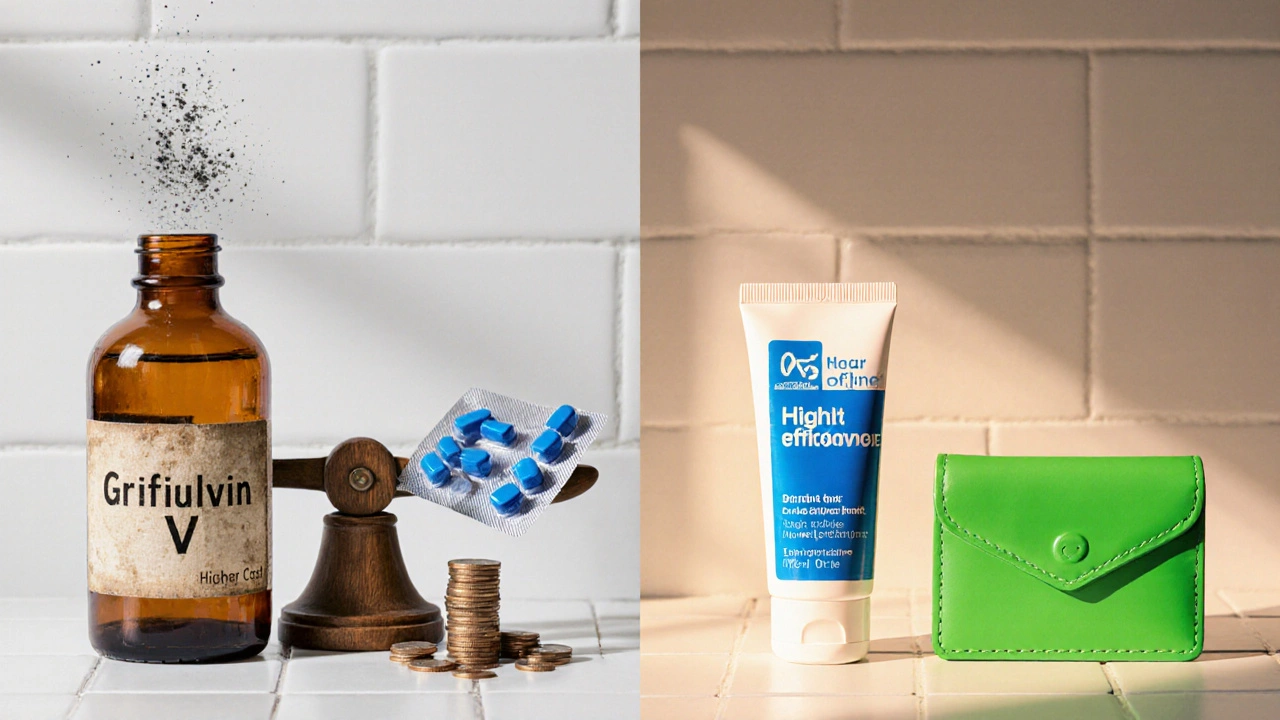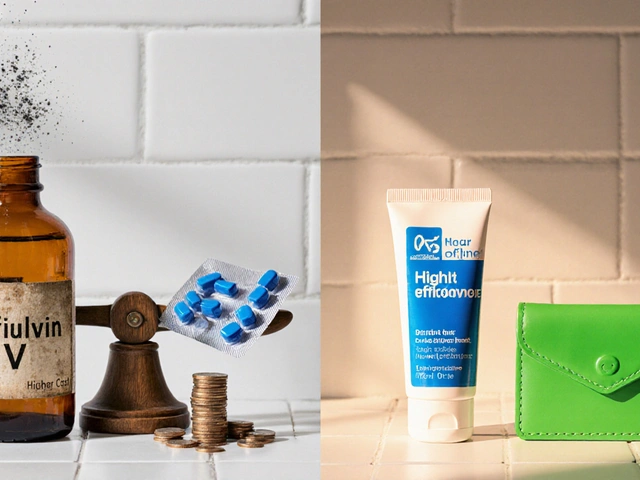Antifungal Treatment Selector
This tool helps determine which antifungal treatment may be best for your condition based on key factors.
Infection Type
Severity
Medical History
Medication Interactions
Quick Take
- Grifulvin V (griseofulvin) is an older oral drug for skin‑round fungus, but it works slower than newer options.
- Terbinafine and itraconazole typically clear infections in weeks, not months.
- Topical agents like clotrimazole or ketoconazole are great for mild cases and have fewer systemic side effects.
- Drug interactions matter - griseofulvin can affect birth‑control pills and many other meds.
- Choosing the right antifungal depends on infection type, severity, and your health history.
When a doctor prescribes an antifungal, the decision often comes down to how quickly you need relief, how deep the infection runs, and what other medicines you’re taking. Below you’ll find a side‑by‑side look at Grifulvin V and the most common alternatives, plus practical advice on matching a drug to your situation.
What Is Grifulvin V?
Grifulvin V is a brand‑name formulation of griseofulvin, an oral antifungal that has been used since the 1950s to treat infections caused by dermatophytes - the fungi that live in hair, skin and nails. It works by attaching to fungal microtubules, disrupting cell division, and essentially halting the spread of the organism. Because it only targets actively growing fungus, it needs to be taken for a long period (usually 6‑12 weeks) to let newly formed healthy skin replace the infected tissue.
When Do Doctors Reach for Grifulvin V?
The drug shines in two niche scenarios:
- Extensive scalp ringworm (tinea capitis) in children - topical creams can’t penetrate the hair shaft, so an oral agent is required.
- Patients who cannot tolerate newer drugs because of liver issues or severe drug interactions.
For most adult skin infections, newer agents tend to be faster and easier to tolerate.
Top Alternatives at a Glance
Below are the major oral and topical antifungals that clinicians consider as replacements for griseofulvin.
- Terbinafine - a synthetic allylamine taken once daily for 2‑6 weeks; excellent for nail and skin infections.
- Itraconazole - a triazole with a broad spectrum, given in pulse dosing (one week on, three weeks off) for stubborn cases.
- Fluconazole - another triazole, often used for yeast infections but also effective against some dermatophytes.
- Clotrimazole - a topical imidazole cream or spray; best for localized patches.
- Ketoconazole - available as a shampoo or cream; useful for scalp and body lesions.

Side‑Effect Profile Comparison
Understanding how each drug might affect you is essential, especially if you have pre‑existing conditions.
| Drug | Common Side Effects | Serious Risks | Drug Interactions |
|---|---|---|---|
| Grifulvin V (griseofulvin) | Headache, GI upset, photosensitivity | Liver enzyme elevation, bone marrow suppression (rare) | Oral contraceptives, warfarin, antiretrovirals |
| Terbinafine | Taste disturbance, rash, GI discomfort | Liver toxicity (monitor LFTs) | CYP2D6 substrates, some antidepressants |
| Itraconazole | Nausea, dizziness, headache | Severe hepatotoxicity, cardiac failure (rare) | Statins, calcium channel blockers, macrolide antibiotics |
| Fluconazole | Headache, abdominal pain, rash | Liver injury, QT prolongation (high doses) | Warfarin, oral contraceptives, some antidiabetics |
| Clotrimazole | Local itching, burning | Rare systemic absorption; minimal serious risk | None significant when used topically |
| Ketoconazole | Scalp irritation, dryness | Hepatotoxicity (oral), adrenal suppression (rare) | Similar to itraconazole; avoid with CYP3A4 inhibitors |
Effectiveness and Treatment Duration
Time to cure matters a lot. Here’s a rough guide based on clinical data and real‑world use:
- Grifulvin V: 6‑12 weeks for scalp ringworm; up to 8 weeks for body skin infections.
- Terbinafine: 2‑4 weeks for skin, 6‑12 weeks for nails - usually faster clear‑up than griseofulvin.
- Itraconazole: 3‑6 weeks for skin, pulse therapy for nails (1 week per month for 3‑4 months).
- Fluconazole: 2‑4 weeks for most dermatophytes, but less effective for nail involvement.
- Topical agents (clotrimazole, ketoconazole shampoo): 1‑4 weeks for mild patches; not suitable for deep or nail disease.
Cost and Accessibility
Price can sway the decision, especially if you’re buying from an online pharmacy. Approximate UK retail prices (as of 2025):
- Grifulvin V 500mg tablets - £12 for a 30‑day supply.
- Terbinafine 250mg - £9 for a 28‑day course.
- Itraconazole 100mg - £15 for a 14‑day pack (pulse dosing).
- Fluconazole 200mg - £8 for a 7‑day pack.
- Clotrimazole cream 1% - £4 for a 30g tube.
Insurance coverage varies; many NHS prescriptions favor newer agents because of shorter therapy length.
How to Choose the Right Antifungal
Use this simple decision tree:
- Is the infection limited to a small patch of skin? → Try a topical (clotrimazole or ketoconazole shampoo).
- Does it involve the scalp or nails? → Consider an oral agent.
- Do you need a fast cure (e.g., before a wedding, sport season)? → Terbinafine or itraconazole are usually quicker.
- Are you on multiple medications or have liver disease? → Grifulvin V may be safer for some, but check drug‑interaction tables.
- Is cost a major factor? → Compare pharmacy prices; often terbinafine is the cheapest effective oral option.
Always discuss with your GP or pharmacist before switching, especially if you’ve experienced side effects with a previous antifungal.
Key Takeaways
- Grifulvin V remains useful for children with scalp ringworm and for patients who can’t tolerate newer drugs.
- For most adults, terbinafine offers faster relief with a shorter treatment window.
- Topical agents are first‑line for mild, localized disease and have the lowest systemic risk.
- Check drug interactions - griseofulvin can lower the effectiveness of birth‑control pills.
- Cost, speed of cure, and safety profile should guide the final choice.

Frequently Asked Questions
Can I use Grifulvin V for nail fungus?
Grifulvin V can treat onychomycosis, but it requires a very long course (often 6‑12 months) and has lower cure rates than terbinafine or itraconazole. Most clinicians now prescribe newer agents for nail infections.
Do I need to take Grifulvin V with food?
Yes. Griseofulvin’s absorption improves when taken with a fatty meal, so doctors usually advise a full‑glass of milk or a snack containing some fat.
Is it safe to combine Grifulvin V with oral contraceptives?
Griseofulvin induces liver enzymes that can reduce the effectiveness of hormonal birth control. Use a backup method (condoms or a second form of contraception) while on the medication.
How quickly will I see results with terbinafine compared to Grifulvin V?
Most patients notice symptom improvement within 1‑2 weeks on terbinafine, whereas griseofulvin may take 3‑4 weeks before any visible change appears, because it only stops new fungal growth.
Can I switch from Grifulvin V to another antifungal mid‑treatment?
A switch is possible but should be guided by a clinician. They’ll consider liver function, current side effects, and whether the infection has responded. A short wash‑out period is rarely needed because griseofulvin clears quickly from the bloodstream.



Ashley Stauber
September 28 2025Grifulvin V is just a relic that modern doctors shouldn't bother prescribing.
Amy Elder
October 2 2025If you need a quick fix, terbinafine usually does the trick.
Erin Devlin
October 5 2025Choosing a drug is a balance between efficacy, safety, and personal circumstance.
Allison Marruffo
October 9 2025For most patients with mild skin patches, a topical like clotrimazole offers a safe, effective start before considering oral options.
Ian Frith
October 12 2025Grifulvin V may appear outdated, but its mechanism still provides a valuable option for specific cases. It works by binding to fungal microtubules, halting cell division, which explains its slower but steady action. Because it only affects actively growing fungi, a prolonged course of six to twelve weeks is often required. This duration can be a drawback for patients seeking rapid relief, especially when newer agents promise cures in weeks. Nevertheless, its safety profile in patients with compromised liver function can be advantageous over some triazoles. The drug’s interaction with hormonal contraceptives is well‑documented, necessitating backup methods during therapy. In pediatric scalp ringworm, Grifulvin V remains one of the few oral agents capable of penetrating the hair shaft. For nail infections, however, its cure rates lag behind terbinafine and itraconazole, which achieve higher success in shorter periods. Cost considerations also play a role; while not the cheapest, Grifulvin V is often covered by insurance where newer drugs are not. Clinicians must weigh the trade‑off between treatment length, side‑effect burden, and drug‑drug interactions. Real‑world experience shows that patients who can tolerate the longer regimen often appreciate the lower risk of hepatotoxicity. Conversely, individuals with active liver disease may still prefer Grifulvin V despite its slower pace because alternative oral agents can exacerbate liver enzymes. The decision matrix becomes even more complex when multiple comorbidities and concurrent medications enter the picture. Ultimately, shared decision‑making with the patient, reviewing the evidence, and considering personal preferences guide the final choice. In my practice, I reserve Grifulvin V for cases where other agents are contraindicated or have failed. When used appropriately, it can be a reliable, albeit patient‑intensive, tool in the antifungal arsenal.
Beauty & Nail Care dublin2
October 14 2025Wow, that sounds like a secret labratory experiment 😱. I swear the pharma giants hide the real cure, they don't want us to know! Grifulvin V is probably just a placebo, lol 😂. Trust the natural stuff, not the synthetic pills. Also, did you notice the hidden code in the packaging? 🤔
Oliver Harvey
October 17 2025Because a three‑month regimen that merely halts fungal proliferation sounds like an efficient cure, right? :)
Ben Poulson
October 20 2025From a pharmacological perspective, the comparative efficacy of griseofulvin versus newer azoles warrants rigorous meta‑analysis, particularly in light of evolving resistance patterns.
Raghav Narayan
October 24 2025When evaluating antifungal therapy, one must first delineate the anatomical site of infection, as this fundamentally influences drug penetration and therapeutic success. In cases of tinea capitis, oral agents are indispensable because topical formulations cannot traverse the hair follicle. Conversely, for limited cutaneous lesions, a topical agent such as clotrimazole achieves sufficient cure rates with minimal systemic exposure. Patient comorbidities, especially hepatic impairment, dictate the selection of agents with favorable safety margins, thereby often positioning griseofulvin as a viable alternative. Nevertheless, the slower onset of action associated with griseofulvin demands diligent patient counseling to set realistic expectations regarding the timeline of clinical improvement. Cost‑effectiveness analyses frequently reveal that, despite its longer duration, griseofulvin remains economically competitive in healthcare systems where newer drugs are priced at a premium. Drug–drug interactions, notably the induction of cytochrome P450 enzymes, must be meticulously reviewed to avoid compromising concomitant therapies, including oral contraceptives. Ultimately, shared decision‑making, incorporating evidence‑based guidelines and individual patient preferences, ensures optimal therapeutic outcomes. I encourage clinicians to maintain a balanced perspective, recognizing both the merits and limitations of each antifungal option.
Tara Phillips
October 26 2025Your comprehensive overview underscores the importance of individualized care, and I commend your dedication to patient‑centred therapy.
Derrick Blount
October 30 2025Grifulvin V, though older, offers, in certain scenarios, a reliable alternative, especially when liver function, drug interactions, and cost, all align unfavourably with newer agents.
Anna Graf
November 1 2025Grifulvin works but takes time.
Jarrod Benson
November 3 2025Man, I was scrolling through that antifungal showdown and honestly, it blew my mind how many options are out there! If you’re sick of waiting weeks for a cure, grab the terbinafine, it’s like the fast‑food of meds – quick, efficient, and gets the job done. But hey, don’t write off the old‑school Grifulvin V just because it’s a bit slower; it’s been a lifesaver for a lot of folks who can’t handle the liver‑hit of the newer pills. Just remember to watch your birth control if you’re on it, because that drug loves to mess with hormones. Bottom line: talk to your doc, weigh the pros and cons, and pick the one that fits your schedule and health vibe.